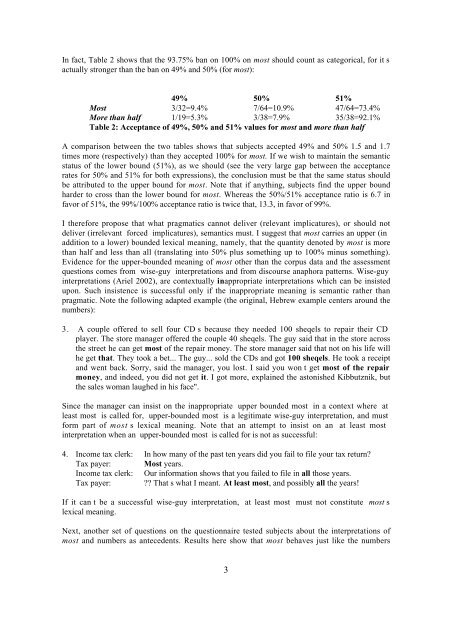SemPrag03.Progr.pdf - Institut für Linguistik/Germanistik - Universität ...
SemPrag03.Progr.pdf - Institut für Linguistik/Germanistik - Universität ...
SemPrag03.Progr.pdf - Institut für Linguistik/Germanistik - Universität ...
Create successful ePaper yourself
Turn your PDF publications into a flip-book with our unique Google optimized e-Paper software.
In fact, Table 2 shows that the 93.75% ban on 100% on most should count as categorical, for it s<br />
actually stronger than the ban on 49% and 50% (for most):<br />
49% 50% 51%<br />
Most 3/32=9.4% 7/64=10.9% 47/64=73.4%<br />
More than half 1/19=5.3% 3/38=7.9% 35/38=92.1%<br />
Table 2: Acceptance of 49%, 50% and 51% values for most and more than half<br />
A comparison between the two tables shows that subjects accepted 49% and 50% 1.5 and 1.7<br />
times more (respectively) than they accepted 100% for most. If we wish to maintain the semantic<br />
status of the lower bound (51%), as we should (see the very large gap between the acceptance<br />
rates for 50% and 51% for both expressions), the conclusion must be that the same status should<br />
be attributed to the upper bound for most. Note that if anything, subjects find the upper bound<br />
harder to cross than the lower bound for most. Whereas the 50%/51% acceptance ratio is 6.7 in<br />
favor of 51%, the 99%/100% acceptance ratio is twice that, 13.3, in favor of 99%.<br />
I therefore propose that what pragmatics cannot deliver (relevant implicatures), or should not<br />
deliver (irrelevant forced implicatures), semantics must. I suggest that most carries an upper (in<br />
addition to a lower) bounded lexical meaning, namely, that the quantity denoted by most is more<br />
than half and less than all (translating into 50% plus something up to 100% minus something).<br />
Evidence for the upper-bounded meaning of most other than the corpus data and the assessment<br />
questions comes from wise-guy interpretations and from discourse anaphora patterns. Wise-guy<br />
interpretations (Ariel 2002), are contextually inappropriate interpretations which can be insisted<br />
upon. Such insistence is successful only if the inappropriate meaning is semantic rather than<br />
pragmatic. Note the following adapted example (the original, Hebrew example centers around the<br />
numbers):<br />
3. A couple offered to sell four CD s because they needed 100 sheqels to repair their CD<br />
player. The store manager offered the couple 40 sheqels. The guy said that in the store across<br />
the street he can get most of the repair money. The store manager said that not on his life will<br />
he get that. They took a bet... The guy... sold the CDs and got 100 sheqels. He took a receipt<br />
and went back. Sorry, said the manager, you lost. I said you won t get most of the repair<br />
money, and indeed, you did not get it. I got more, explained the astonished Kibbutznik, but<br />
the sales woman laughed in his face".<br />
Since the manager can insist on the inappropriate upper bounded most in a context where at<br />
least most is called for, upper-bounded most is a legitimate wise-guy interpretation, and must<br />
form part of most s lexical meaning. Note that an attempt to insist on an at least most<br />
interpretation when an upper-bounded most is called for is not as successful:<br />
4. Income tax clerk: In how many of the past ten years did you fail to file your tax return?<br />
Tax payer: Most years.<br />
Income tax clerk: Our information shows that you failed to file in all those years.<br />
Tax payer: ?? That s what I meant. At least most, and possibly all the years!<br />
If it can t be a successful wise-guy interpretation, at least most must not constitute most s<br />
lexical meaning.<br />
Next, another set of questions on the questionnaire tested subjects about the interpretations of<br />
most and numbers as antecedents. Results here show that most behaves just like the numbers<br />
3

















